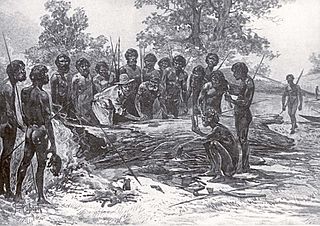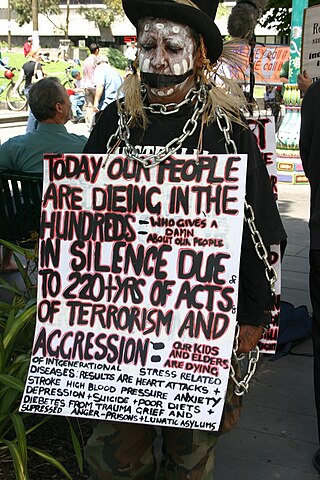Related Research Articles

The Wurundjeripeople are an Australian Aboriginal people of the Woiwurrung language group, in the Kulin nation. They are the traditional owners of the Yarra River Valley, covering much of the present location of Melbourne. They continue to live in this area and throughout Australia. They were called the Yarra tribe by early European colonists.

The Kulin nation is an alliance of five Aboriginal nations in south central Victoria, Australia. Their collective territory extends around Port Phillip and Western Port, up into the Great Dividing Range and the Loddon and Goulburn River valleys.

John Batman was an Australian grazier, entrepreneur and explorer. He is best known for his role in the founding of Melbourne.

William Barak, named Beruk by his parents,, the "last chief of the Yarra Yarra tribe", was the last traditional ngurungaeta (elder) of the Wurundjeri-willam clan, the pre-colonial inhabitants of present-day Melbourne, Australia. He became an influential spokesman for Aboriginal social justice and an important informant on Wurundjeri cultural lore.
The Boonwurrung people are an Aboriginal people of the Kulin nation, who are the traditional owners of the land from the Werribee River to Wilsons Promontory in the Australian state of Victoria. Their territory includes part of what is now the city and suburbs of Melbourne. They were called the Western Port or Port Philip tribe by the early settlers, and were in alliance with other tribes in the Kulin nation, having particularly strong ties to the Wurundjeri people.

Batman's Treaty was an agreement between John Batman, an Australian grazier, businessman and coloniser, and a group of Wurundjeri elders, for the purchase of land around Port Phillip, near the present site of Melbourne. The document came to be known as Batman's Treaty and is considered significant as it was the first and only documented time when Europeans negotiated their presence and occupation of Aboriginal lands directly with the traditional owners. The treaty was implicitly declared void on 26 August 1835 by the Governor of New South Wales, Richard Bourke.

The Taungurung people, also spelt Daung Wurrung, are an Aboriginal people who are one of the Kulin nations in present-day Victoria, Australia. They consist of nine clans whose traditional language is the Taungurung language.
The Port Phillip Association was formally formed in June 1835 to settle land in what would become Melbourne, which the association believed had been acquired by John Batman for the association from Wurundjeri elders after he had obtained their marks to a document, which came to be known as Batman's Treaty.

Woiwurrung and Taungurung are Aboriginal languages of the Kulin nation of Central Victoria. Woiwurrung was spoken by the Woiwurrung and related peoples in the Yarra River basin, and Taungurung by the Taungurung people north of the Great Dividing Range in the Goulburn River Valley around Mansfield, Benalla and Heathcote. They are often portrayed as distinct languages, but they were mutually intelligible. Ngurai-illamwurrung (Ngurraiillam) may have been a clan name, a dialect, or a closely related language.
The murnong or yam daisy is any of the plants Microseris walteri, Microseris lanceolata and Microseris scapigera, which are an important food source for many Aboriginal peoples in southern parts of Australia. Murnong is a Woiwurrung word for the plant, used by the Wurundjeri people and possibly other clans of the Kulin nation. They are called by a variety of names in the many different Aboriginal Australian languages, and occur in many oral traditions as part of Dreamtime stories.

Dja Dja Wurrung, also known as the Djaara or Jajowrong people and Loddon River tribe, are an Aboriginal Australian people who are the traditional owners of lands including the watersheds of the Loddon and Avoca rivers in the Bendigo region of central Victoria, Australia. They are part of the Kulin alliance of Aboriginal Victorian peoples. There are 16 clans, which adhere to a patrilineal system. Like other Kulin peoples, there are two moieties: Bunjil the eagle and Waa the crow.

Currawong Bush Park is a nature park located in the outer eastern Melbourne suburbs of Doncaster East, Warrandyte and Donvale, along Mullum Creek. It covers 59 hectares of remnant bushland and contains archaeological sites significant to the Traditional Owners of the area, the Wurundjeri people of the Kulin nation.
Billibellary was a song maker and influential ngurungaeta of the Wurundjeri-willam clan during the early years of European settlement of Melbourne. He was known by various names including Billi-billeri, Billibellary, Jika Jika, Jacky Jacky and Jaga Jaga. He was an astute and diplomatic leader, described as powerfully built with an influence and reputation that extended well beyond his clan.

The Wurundjeri Woi Wurrung Cultural Heritage Aboriginal Corporation, previously the Wurundjeri Tribe Land and Compensation Cultural Heritage Council, is a Registered Aboriginal Party representing the Wurundjeri people, an Aboriginal Australian people of Victoria.
Melbourne Day is an annual celebration to mark the founding of Melbourne in Victoria, Australia, on 30 August 1835.

The Kulin languages are a group of closely related languages of the Kulin people, part of the Kulinic branch of Pama–Nyungan.

Aboriginal Victorians, the Aboriginal Australians of Victoria, Australia, occupied the land for tens of thousands of years prior to European settlement. Aboriginal people have lived a semi-nomadic existence of fishing, hunting and gathering, and farming eels in Victoria for at least 40,000 years.

The Woiwurrung, also spelt Woi-wurrung, Woi Wurrung, Woiwurrong, Woiworung, Wuywurung, are an Aboriginal Australian people of the Woiwurrung language group, in the Kulin alliance.
The Bunurong Land Council Aboriginal Corporation is a Registered Aboriginal Party and incorporated association representing the Bunurong community in the state of Victoria, Australia, particularly in matters relating to the Victorian Aboriginal Heritage Act 2006.

N’arweet Carolyn Briggs is a Yaluk-ut Weelam and Boon Wurrung elder, and the Boon Wurrung representative in the City of Port Phillip. She is the founder and chair of the Boon Wurrung Foundation. She was awarded the National Aboriginal Elder of the Year in 2011 by the National NAIDOC Committee. She was inducted into the Victorian Honour Roll of Women in 2005. She was awarded a Member of the Order of Australia (AM) as part of the 2019 Queen’s Birthday Honours list.
References
- ↑ Clark, Ian D. & Cahir, David A. (2004). Tanderrum: 'Freedom of the Bush' (PDF). Castlemaine, Vic.: Friends of Mount Alexander Diggings. ISBN 0-9579308-2-8. Archived from the original (PDF) on 24 July 2005.
- ↑ Royal Botanic Gardens Melbourne Education Service. "Teachers Kit" (PDF). Aboriginal Resources Trail. Royal Botanic Gardens Melbourne. Archived from the original (PDF) on 2 October 2006. Retrieved 8 June 2009.
- ↑ Kenny, Robert (2008). "Tricks or treats? A case for Kulin knowing in Batman's treaty". History Australia. 5 (2): 38.1–38.14. doi:10.2104/ha080038. S2CID 143485675.
- ↑ Parks Victoria. "Herring Island Environmental Sculpture Park" (PDF). Park Notes. Parks Victoria. Archived from the original (PDF) on 31 July 2008. Retrieved 8 June 2009.